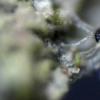
21-12-2025 09:32
Hello.A tiny ascomycete found embedded in wood in

21-12-2025 21:32
Pol DebaenstHello, Garden, Burgweg 19, Veurne, BelgiumOn 10/1

22-12-2025 23:38
Patrice TANCHAUDBonsoir, récolte sur un mur en pierre, apothéci

22-12-2025 00:47
Patrice TANCHAUDBonsoir, récolte à proximité du milieu dunaire

21-12-2025 21:40
Isabelle CharissouBonjour, j'aimerais connaitre les références de

21-12-2025 21:31
Pol DebaenstHello, Garden, Burgweg 19, Veurne, BelgiumOn 10/1

21-12-2025 21:31
Pol DebaenstHello, Garden, Burgweg 19, Veurne, BelgiumOn 10/1

20-12-2025 23:08
Patrice TANCHAUDBonsoir, récolte sur sol sablonneux dans l'arri�
While looking at lichens on a twig under a dissecting microscope, I noticed what looked like 100 um perithecia (some spherical, others apparently deflated into tiny black buttons) apparently growing on an algal crust on a Prunus spinosa twig. I now see they are called chasmo- or cleistothecia.
They look very similar to Erysiphe species (rather similar to E flexuosa on Aesculus? Update: similar, but not as wavy), with c. 100 um appendages about 6 um wide, with hooked tips.
There are several asci per cleistothecium, each with what looks like at least 8 ascospores. The asci are c 55 x 40 um. The spores are 15.5-17.9 x 9.9-11.3 um (5 spores measured).
Warwickshire, UK Thanks for any information.
It does not answer your question per se but I find these fungi from time to time on bryophytes. It seems that mature fruitbodies fall from vascular plants, as they are not connected to other things via mycelium. I guess the blow around like a tumbleweed and disperse spores further away if the ascomata can act as propagules themselves. The hairs may allow them to get hooked onto vectors. Not sure, just a theory based on my own observations and thoughts.
All the best,
George





